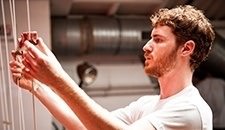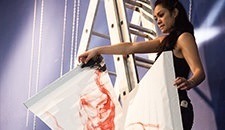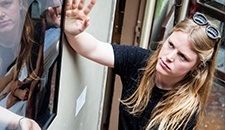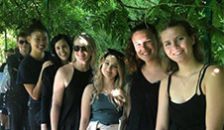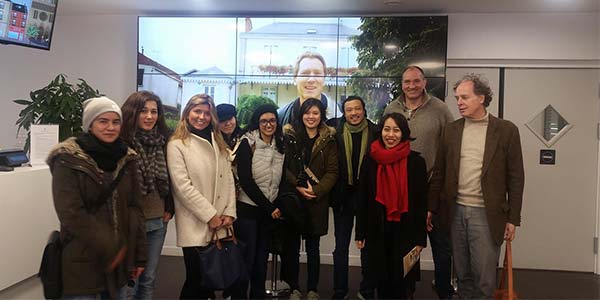
Reims, the administrative capital of Champagne is just over an hour from Paris by TGV. Arriving at the train station, the town centre is literally a 5-minute walk away, and our small, independent hotel had the advantage of being both affordable and right in the centre and so a short walk from the station. We designed the tour to function entirely on foot and by train, so that we could have a more intimate connection with the places we visited, and also reduce our carbon footprint.
Though small and rather provincial, Reims has an extraordinary history and is also home to a number of the major Champagne houses (Veuve Cliquot, Ruinart, Tattinger, Mumm, Lanson, Pommery…). Champagne is a word that immediately conjures images of ritual, festivity and celebration, and has become the ineluctable companion to weddings around the globe. But just like Parisians don’t visit the Eiffel Tower or the Louvre or Notre Dame every day, the Rémois, unsurprisingly, don’t drink Champagne every day. There is in fact very little to indicate, at first glance, that there are literally millions of bottles stored in underground cellars here and corks popping on a regular basis all over town in restaurants and wine bars.
Our first visit was a meeting with the director of the ‘Office de Tourisme’, who shared with us the strategies his office has undertaken to help stimulate regional tourism. This may seem surprising given the world’s enthusiasm for its wines, but as a tourist destination, it is greatly underdeveloped.
Mondays are often quiet in France as Sunday is a traditional market day, and so a lot of restaurants close. But we managed to locate an organic restaurantwithin the students’ budget serving a range of wraps, salads and sandwiches that was bright and spacious and perfectly located just behind the cathedral.
Vranken Pommery Champagne was next on our list and only about a kilometre walk from the cathedral. Apart from the Champagne tour, which offers a comprehensive overview of the ‘méthode champenoise’ via a tour of the labyrinthine limestone cellars, some of which were former quarries, Pommery has a rather eclectic contemporary art collection with the current exhibition featuring works by Daniel Firmin and Chris Burden, among others.
Walking back, we passed through the Parc de la Butte Saint Nicaise, which features vestiges of the ramparts built to defend the city against the English in the Hundred Years war. Arriving at the cathedral, we stood on the ‘parvis’ in admiration of this 800-year old monument to Christianity, which has also served for the coronation of countless kings since the 11th century. Majestic and timeless, with so many tales to tell, you feel awed by its immensity and grace. Behind the altar are stained-glass windows designed by Marc Chagall.
But the highlight of our study trip was undoubtedly our visit to Leclerc Briant in Epernay. Following a quiet evening with everyone fending for themselves for dinner, we walked back to the train station in the morning and boarded a local train to the capital of Champagne, Epernay.
Between Reims and Epernay there are endless vineyards, all of which looked lifeless in their leafless winter state. The odd vineyard worker could be seen pruning, burning the cut branches to stay warm in a mobile incinerator stuck on a wheel barrow.
Leclerc Briant is a small Champagne house with a fascinating story, as it was on the brink of being lost forever when an American couple stepped in to save it from oblivion. It has been farmed biodynamically since the 1990’s and though it’s production has always been small, its reputation has been consistently grand. The wines are now made by Hervé Jestin, who is as passionate about the energy in wine as he is about the natural forces and life cycles at work in the vineyard. Biodynamic farming is not just a method, it is also a philosophy of life that focusseson harnessing life forces and creating harmony and balance. It is a kind of medicine for the soil that helps increase macro-biological life, which reinforces the immune systems of plants. There are only about 20 biodynamic domains among the 5,000 champagnes produced.
In an ongoing search for excellence, Leclerc Briant has engaged in a number of experiments to improve the quality and increase the level of energy found in their wines. Ageing the wines in the sea is one experiment, which has also been done by other vineyards and not just in Champagne. Using terra-cotta amphora and experimenting with different kinds of barrels is also being done, but more importantly, they have taken into account the telluric and geo-magnetic forces present in the winery and made adjustments accordingly.
But one experiment is truly unique and surprising, and they have the distinction of being the only vineyard in the world to do so. This involves ageing in a gold-lined barrel made of stainless steel, which has around 30,000 euros worth of gold lining it. What effect exactly the gold will have,has yet to be seen, as they have only this year begun the experiment. We’ll have to wait a year to find out what sort of alchemy is at work in this experiment…
But if it improves on what is already being made, then there will be no getting anywhere near it as it will be snatched up before it’s even released. The tasting that followed our visit was a revelation for all, as no one had ever tasted such delicious, complex and aromatic wines before, all of which had extraordinary presence, balance and depth. The sensation of tasting was enlivening as well and did in fact make us all feel energised, so these extra efforts seem to pay off.
Following our visit at Leclerc Briant we walked back into town for lunch and then walked up to the far end of the Avenue de Champagne for a final visit to Michel Gonet. This is also a small family Champagne house with about 40 hectares of vines, 80% of which are planted to chardonnay, mostly aroundAvize, Oger and Le Mesnil sur Oger south of Epernay. Sadly, the wines by contrast with the exuberantly dynamic wines of Leclerc Briant seemed flat and lifeless, though very much in the style of the big Champagne houses. These are wines that would pass unnoticed (which is sadly too often the case with Champagne) during any kind of festivity, enthusiastically guzzled and enjoyed because of their sparkle and the very heady effect sparkling wines produce.
Our walk back to the train station was uneventful and a bit sad as we felt as though we had only just begun our exploration and there was so much more to see. Though we’d only scratched the surface of this world-famous wine region, we did nevertheless have a very satisfying experience that helped all of us to better understand what goes on behind the scenes in Champagne. The region isn’t going anywhere, so it is always possible to go back for more…
More information about IESA's MBA in Cultural Entrepreneurship and Tourism and MBA in Arts & Luxury Management.
IESA also organized a study trip to Florence so that its students can experience the city's cultural heritage first-hand.


 Download application form
Download application form 